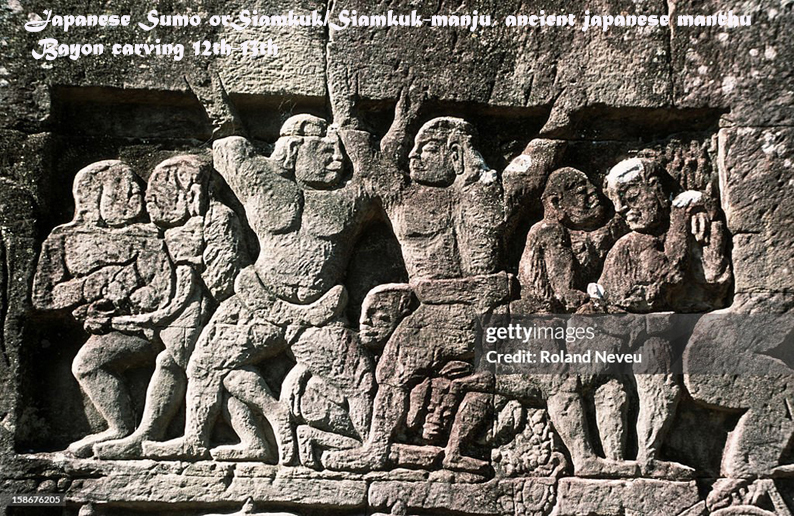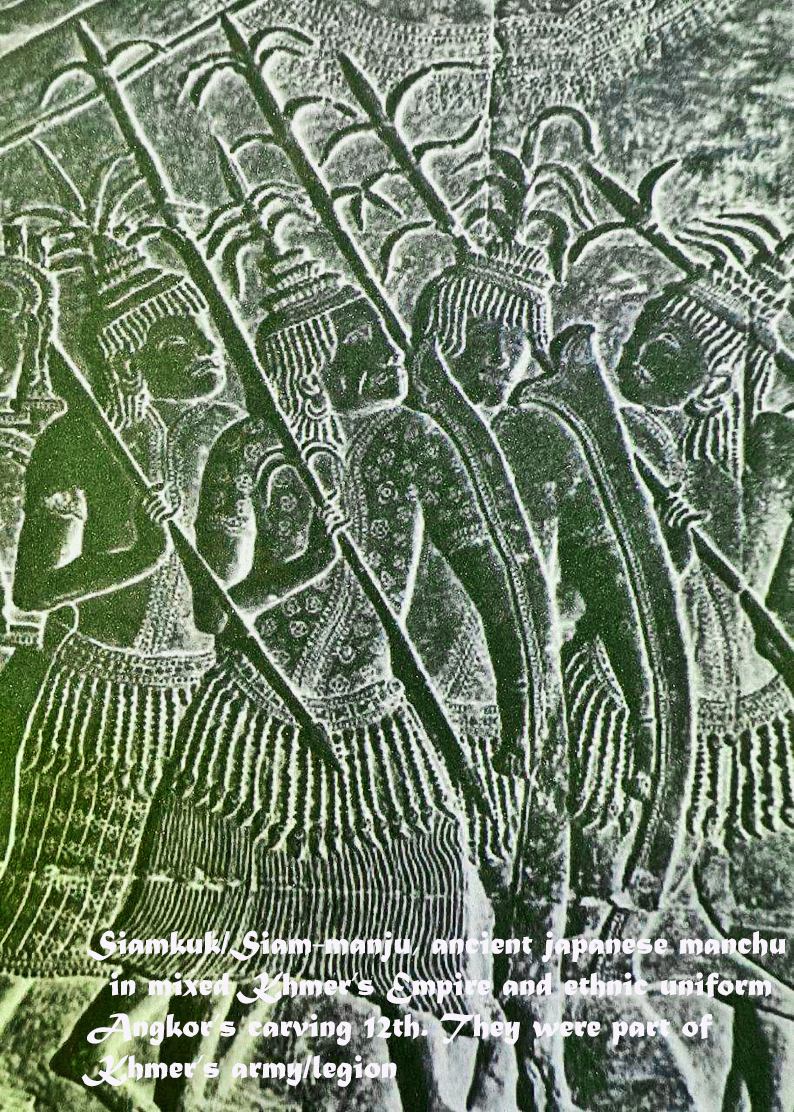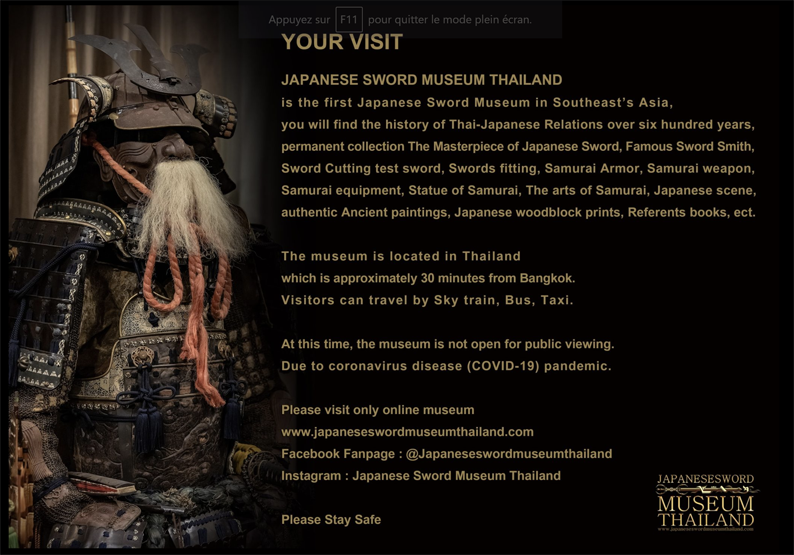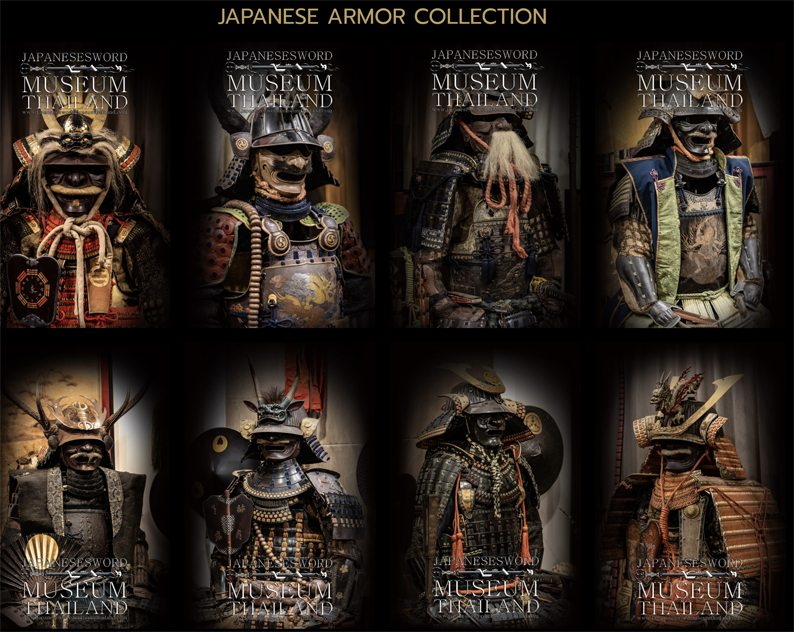| The powerful Khmer's army in action engraved on the walls of Khmer temples 1-2-3-4-5-6-7- Chinese warriors, tai japanese manchu at Angkor, Bayon bas-relief - tai qing mingmang, vn mingmang macu warriors, Tang and the stolen Khmer's artefact at Singapore's museum, Khmer's traditional food, busy cooking scence on Bayon carving, គេកម្ររប្រទះឃើញឯកសារ ស្រាវជ្រាវពីវត្តមានជនជាតិជប៉ុនមកជ្រកកោនស្នាក់នៅបំរើអណាចក្រខ្មែរណាស់ តែបើ ក្រឡេក មើលលើជញ្ជាំងប្រសាទខ្មែរវិញ យើងនឹងមានការភ្ញាក់ផ្អើល ដោយប្រទះឃើញចម្លាក់ពីក្រុមប្រយុទ្ធជប៉ុន ក្នង ទម្រង់ ជាល្បែងប្រយុទ្ធ ស៊ូម៉ូ ឬក្នុងទម្រង់ ក្បាច់គុនល្បុកកតោ លើប្រាង្គបាយ័ន្ត។ ចំណែក ឯកសារថៃវិញ បានសរសេរពី វត្តមានសហគមន៍ជនជាតិជប៉ុន នៅតំបន់ អាយុធ្យាត្រឹមចុងស.តទី១៣ ឬ ១៤។ បើពិនិត្យលើរូបទី១ និងទី២ ចម្លាក់រូប អ្នកប្រយុទ្ធ ស៊ូម៉ូ មានពុកមាត់ របៀបចិន ដែលអាចបញ្ជាក់ថា ពួកគេ ជាជនជាតិជប៉ុន ឬចិនឈិន។ ដូច្នេះ វាមិន ចម្លែកទេ បើមានវត្តមានសហគមន៍ជប៉ុនលើទឹកដី អាយុធ្យា ក្នុងសម័យបង្កើតប្រទេសថៃ នៅពាក់កណ្តាល ស.តទី១៤។ កន្លងមក អ្នកសិក្សាស្រាវជ្រាវប្រវត្តិសាស្ត្រទាំងអន្តរជាតិ និងខ្មែរ តែងមានមតិជម្រោងចម្រះ ជាច្រើនទាក់ទងនឹង កងប្រយុទ្ធមួយក្រុម មានមុខមាត់ស្រដៀងចិនបន្តិច ម៉ុងហ្គោលបន្តិច ដែលត្រូវបាន ឆ្លាក់លើផ្ទាំងប្រាសាទអង្គរ ជាមួយនឹងចំណារថា សៀមកុក។ តាមរូបរាងជាក់ស្តែងលើចម្លាក់ ពួកគេមានលក្ខណៈស្រដៀងនឹងជនជាតិចិន ប៉ុន្តែមិនដូច ជនជាតិចិន ធម្មតានោះទេ។ ប្រជាជនថៃសម័យថ្មីបានអះអាងថា សៀមកុក ដែលឆ្លាក់លើផ្ទាំងប្រាសាទ អង្គរ ជាបុព្វបុរសរបស់ពួកគេ ប៉ុន្តែវាហាក់ដូចជាមិន ដូច្នោះទេ។ អ្នកប្រាជ្ញមួយចំនួនដូចជាលោក G.Coedes និងអ្នក ស្រាវជ្រាវជាច្រើនទៀត មកពីសាលាបារាំងចុងបូព៌ា EFEO បានសន្មត់ថា ក្រុមមនុស្ស Samkuk ជាមនុស្សដែលមាន សម្បុរស្បែកខ្មៅ។ អ្នកសិក្សាខ្លះទៀតយល់ថា សៀមកុក ជាក្រុមជនជាតិ Kasi ដែលជាប្រភេទក្រុមមនុស្សខ្មែរបុរាណ ឬខ្មែរមន។ អ្នកខ្លះយល់ថា សៀមកុក លើប្រាង្គប្រាសាទអង្គរ ជាជនជាតិអូស្រ្តាស៊ី ម៉ាឡាយូ ឥណ្ឌូនេស៊ី ដូចជាជនជាតិ Dayak hari Gawai, Dayak merah, dayak-merah-jilah, dayak-merah-suku, Iban-sarawak, Jahut, Mah meri, murut, Orang Asli, Pasukan-merah-kawal ethnicrungus-kota-belud ។ល។ តែភិនភាគ បណ្តាប្រជាជាតិអូស្រ្តាស៊ី ម៉ាឡាយូ ឥណ្ឌូនេស៊ី នៃឥណ្ឌូនេស៊ី និងកោះម៉ាឡាយូ ដែលបានរៀបរាប់ខាងលើ មានរូបរាងស្រដៀងខ្មែរបុរាណ ច្រើនជាងក្រុម មនុស្ស សៀមកុក លើប្រាង្គប្រាសាទអង្គរ។ នៅលើវិបសាយ សារមន្ទីរដាវជប៉ុនប្រចាំប្រទេសថៃ ធ្វើឡើងដើម្បីឧទ្ទិសដល់ទំនាក់ទំនងការទូត និងសហប្រតិបត្តិការ យោធារវាងប្រទេសទាំង២ រយៈជាងប្រាំមួយរយឆ្នាំ និងដល់ស្នាដៃដ៏មហិមារបស់កងទ័ពជប៉ុន ក្នុងការកសាង ពង្រីក និងការពារទឹកដីថៃ ដែលប្លន់បានពីខ្មែរ យើងអាចសង្គេតឃើញ រូបភាពអ្នកប្រយុទ្ធជប៉ុនមួយចំនួននៅ ក្នុងឯកសណ្ឋាន និងស្បែកមុខជាបិសាចដ៏កាច សាហាវ គួរឱ្យខ្លាច។ ទំនាក់ទំនងស្និទ្ធរមួតជាង ៦០០ ឆ្នាំ ហាក់ដូចជា ចៃដន្យនឹងការចាប់កំណើតនៃនគរសៀមនៅពាក់កណ្ដាលទី ១៤។ តើមិនមែនជា អ្នកចម្បាំងបិសាចទាំងនោះទេ ដែលបានរួមជាមួយនឹង ចិនត្រកូលសុង បះបោរប្រឆាំងនឹងខ្មែរ ហើយបានបំបែកខេត្តរបស់ខ្មែរពីរ មកបង្កើត ជាកូនប្រទេសសៀម នៅពាក់កណ្តាលស.តទី១៤? នៅលើផ្ទាំងគំនូរប្រវត្តិសាស្ត្រថៃមួយ ដែលពណ៌នាអំពីកងប្រយុទ្ធក្នុងរុជ្ជកាលស្តេចថៃ ណារ៉ៃ ដែលជាអំឡុងថៃធ្វើសឹក សង្គ្រាមស៊ីសាច់ ហុតឈាមខ្មែរនៅបន្ទាយ លង្វែក យើងឃើញវត្តមានអ្នកចម្បាំងជប៉ុនក្នុងឯកសណ្ឋានជាសាមូរ៉ៃជាមួយ នឹងដាវវែង និងដាវសាំម៉ូរ៉ៃ រួមជាមួយនឹងទាហានថៃ ដែលមើលទៅហាក់ដូចជា ជនជាតិចិន។ នេះបញ្ជាក់ថា អ្នកចម្បាំងជប៉ុន និងកងទ័ពចិន មកពីរាជវង្សចិនផ្សេងៗគ្នា តែងមានវត្តមានក្នុងសង្គ្រាម ប្រឆាំងនឹងខ្មែរ។ គួរបញ្ជាក់ដែរថា ក្នុងអំឡុង សង្គ្រាមលោកលើកទី២ ប្រទេសថៃត្រូវបានប្រើប្រាស់ជាមូលដ្ឋានយោធាសម្រាប់ចក្រភព ជប៉ុន វាយលុកប្រទេសផ្សេងទៀតនៅក្នុងអាស៊ាន ក៏ដូចជាប្រឆាំងនឹងលោកខាងលិចផងដែរ។ It is rare to find scholar documents relate to the presence of Japanese refugees or warriors during Khmer's Empire yet there's a bunch of proofs on the walls of Khmer's temples proven that ancient japanese manju had massively settled on Khmer's territory during Khmer's Empire period. It's to say, on the wall of Bayon we can observe japanese Sumo in position of fighting. Few other sculptures showing japanese sumo warriors training or fighting with Khmer's warriors. Thai documents record the presence of the Japanese community in Ayutthaya by the end of the 13th century. If we observe at the first and second pictures, the Sumo warrior of tha wall of Bayon had a Chinese-style beard, which can prove that they are Japanese or Chinese. So it is not uncommon that the ancient japanese manju played a major role in the founding of siamese primitive kingdom at mid 14th by revolting against Khmer's central power, then along with chinese song communities in Ayuthaya, detached 2 Khmer's ancient cities Ayuthaya and Lavo to form primitive thailand or siam kingdom. |
 |
 |
 |
 |
 |
 |
 |
 |
 |
 |
 |
 |
 |
Update Décembre 2023 |
| បណ្ណាល័យព្រលឹងខ្មែរ- 7 | 6 | 5 | 4 | 3 | 2 | 1 | ~ *~ 1 | 2 | 3 | 4 | 5 | 6 | 7 - បណ្ណាល័យព្រលឹងខ្មែរ |